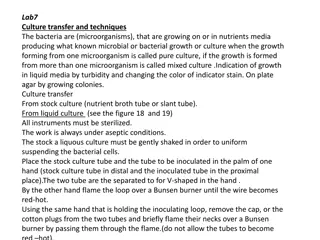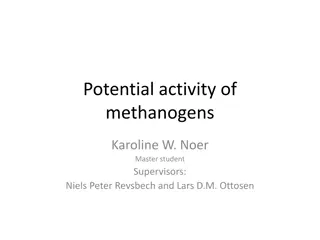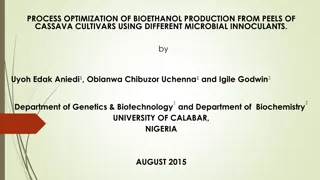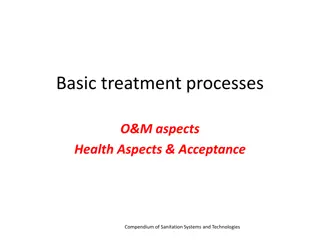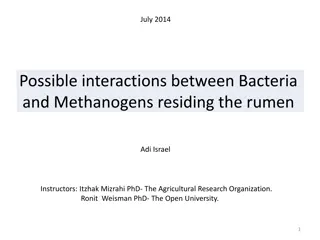Understanding Anaerobic Bacterial Growth and Culturing Methods
Anaerobic bacteria have specific sensitivities to oxygen, with categories such as aerobic, obligate anaerobes, facultative anaerobes, aerotolerant anaerobes, microaerophiles, and capnophilic bacteria. Methods like Anaerobic Jar and GasPak system are used for cultivating anaerobic bacteria, ensuring an oxygen-free environment for growth. Various anaerobic culture media, such as Eugon Agar and Thioglycollate broth, aid in isolating anaerobic bacteria from sources like soil or dental specimens. The process involves careful incubation and observation of isolated colonies.
Download Presentation

Please find below an Image/Link to download the presentation.
The content on the website is provided AS IS for your information and personal use only. It may not be sold, licensed, or shared on other websites without obtaining consent from the author. Download presentation by click this link. If you encounter any issues during the download, it is possible that the publisher has removed the file from their server.
E N D
Presentation Transcript
lab9 . Relationship of O2 to Bacterial growth Microorganisms divided due to their sensitivities to O2 into: Aerobic bacteria the bacteria that grow in the presence of oxygen Obligate or strict anaerobes can grow only in the absence of O2 and are harmed by its presence. Facultative anaerobes can grow either aerobically or anaerobically (in the presence or in the abscence of O2 ) Aerotolerant anaerobes are microorganisms that cannot use O2 , Microaerophiclic microorganisms , that require small amounts of O2 , but are inhibited at normal atmospheric tension of O2 Capnophilic bacteriathe bacteria that need 5-10%CO2 . see (fig. 20).
The principles of Anaerobic Jar use There are another ways (method) for cultivation or culturing of anaerobic bacteria one of them is the Gaspak Anaerobic system (fig. 26). In this system, hydrogen and CO2 are generated by Gaspak envelope after addition of water .A palladium catalyst (pellets) in the chamber lid catalyzes the formed H2 with O2 to form water. Palladium Catalyst 2H2 + O2 -------------- H2O By this reaction quantity of O2 in the chamber is completely reduced. Therefore the environment inside the chamber becomes anaerobically and convenient for the grow of the anaerobic microorganisms. Sometimes instead of Gaspak (H2 and CO2) generator it can be used a flamed wax candle to reduce the O2 inside the Jar chamber. The Anaerobic jar must be tightly closed. -The inoculated agar plates incubate at 37 c for 24-48 hours. - Observe the isolated colonies record the results in your report.
The anaerobic culture media Eugon Agar (PH 7.0). Tryptose 15.0 gm ; soytone 5.0 gm ; Dextrose 5.0 gm; L-cystine 0.2 gm; Sodium Chloride 4.0 gm ;sodium sulfite 0.2 gm ;Agar 15.0 gm;Distilled water 1 liter. Thioglycollate broth (PH 7.0)and agar. Peptone 15.0 gm; yeast extract 5.0 gm ; Dextrose 5.0 gm;L-cystine 0.75 gm; thioglycolate 0.5 gm ;NaCL 2.5 gm;Methylenc or Resazurin 0.001 gm; Dist. Water 1.0 L. 15 gm agar added for thioglycollate agar. Isolation of Anaerobic bacteria from the soil Or Dental specimens (infected root canal or plaque etc).









